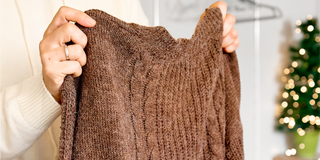Ah, pilling! Those pesky little balls of fibre clinging to the surface of your clothing, making even the (almost) new pieces look dull and worn-out. But have you ever wondered why fabric pilling appears on your fabrics in the first place? And what can you do to prevent or remove it? If yes, you are in the right place!
What is pilling on fabric?
A pill is a small ball of fibre that forms on the surface of your clothing due to wear and abrasion from rubbing against other items (like our skin) and fabrics during the wearing, washing, and drying processes. You may also know pills by the names of bobbles, fuzzballs, and lint balls.
The process in which these small tangles of fibres or balls are formed on your clothing is known as fabric pilling. While many believe that fabric pilling is a sign of bad quality, it’s actually not true! To tell the truth, pilling is a natural fabric fault - one that is bound to happen to your clothing after some period, no matter how much you take care of it, or how much you invest in your wardrobe.
These pills tend to cling to the surface as the fibres are still connected to the yarns in the textile. As a result, the appearance and texture of the fabric changes significantly, making even your favourite pieces of clothing look dull and worn-out only after a couple of washes.
Causes of Pilling
The primary cause of fabric pilling is the wear and abrasion caused during wearing and washing the garments. When the loose fibres are entangled with each other, they protrude from the surface of the clothing. Then, due to the aggressive rubbing action, these loose fibres develop into fluffy balls connected to the textile by some unbroken fibres.
Some fabrics are also more prone to fabric pilling as compared to others due to a higher degree of fibre or yarn hairiness. This hairiness refers to the small, protruding fibres that may exist on the surface of the clothing. When these fibres rub against each other or other external surfaces, they are much more likely to tangle and form pills.
Typically, synthetic fabrics like nylon and polyester are more susceptible to bobbling. Some natural fabrics like cotton can also gather lint and bobbles due to their textile structure and blend ratios.
How to prevent Fabric Pilling on your Fall Wardrobe
When it comes to fabric care, precaution is always better than cure. With some simple laundry care tips and tricks, you can avoid pills and bobbles from appearing on your clothing in the first place.
-
Wash clothing inside out
Clothing rubs against other articles during the washing and drying processes causing it to pill more and more. By washing the fabrics inside out, the visible side of the garment won’t be abraded as much and only the backside of the garment will get pills. This way, your clothing can keep looking and feeling at its best even after multiple spins in the washing machine.
-
Use a garment bag
For your loosely knitted sweaters, try using a large garment bag in the laundry machine. This will prevent a lot of friction from other clothing items in the cycle and reduce the chances of getting pills or bobbles. You can also use this trick for laundering your lingerie or other delicate items.
It is also good practice to choose a gentle or delicate cycle with a slower spin speed when washing your clothes. This helps in reducing the agitation during the laundry process, causing less wear to your clothing.
-
Wash clothes separately
While it may feel like a wastage of resources, using the “extra small load” cycle on the washer can help prevent pilling and lint on your clothing. Some modern appliances enable you to adjust your cycle size and water intake to ensure optimal cleaning and lesser water wastage.
However, keep in mind that even after taking every precaution, fabric pilling is mostly inevitable. For example, wool, fleece, flannel, and other loosely woven fabrics can easily form pills on their surface.
-
Use BIORESTORE Re-Tergent
BIORESTORE cotton is formulated with enzymes which remove lint, pilling, fuzz and bobbles your clothing. For cotton and cotton blends (minimum 70% Cotton), this laundry powder does an excellent job in reviving the fabrics in only one home laundry wash.
However, it’s important to stick with the exact instructions mentioned on the packaging for the best results. For example, if the care label attached to a fabric says, “hand wash only”, you cannot toss it in the washer and cannot use BIORESTORE cotton on it.
-
Handwash clothing whenever possible
While its not possible to say goodbye to machine washing altogether, you can try opting for handwashing every once in a while, to ensure extra gentle care for your clothing.
Similarly, line drying items is a much gentler alternative than machine or tumble drying. All you need is a drying rack, or some clothespins and you can easily ditch the rough and tumble on your clothing from spinning inside the dryer.
Best Fabric Pill Removers for Cotton Sweaters
BIORESTORE Re-Tergent is the best pill remover for clothing made of at least 70% cotton. Simply pick your clothing with lint, pilling, or fuzz on it. Sort the fabrics according to colour and add them to the washer.
According to the instructions mentioned on the packaging, add the recommended amount of BIORESTORE cotton and run the cycle at 40ºC for 2 hours. Once the cycle is finished, toss the fabrics in a tumble drier…and just like that, your clothing will be revived to its original vibrancy, and handfeel.
P.S If a sweater cannot be machine-dried, don’t worry! Just rinse it with a small amount of your regular detergent and lay it flat to dry.





